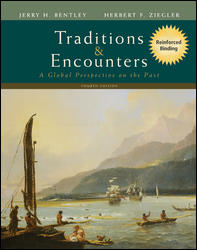 
Traditions and Encounters, 4th Edition (Bentley)Chapter 4:
EARLY SOCIETIES IN SOUTH ASIAChapter Outline- Harappan society
- Background
- Neolithic villages in Indus River valley by 3000 B.C.E.
- Earliest remains inaccessible because of silt deposits and rising water table
- Also little known because writing not yet translated
- Foundations of Harappan society
- The Indus River
- Runs through north India, with sources at Hindu Kush and the Himalayas
- Rich deposits but less predictable than the Nile
- Wheat and barley were cultivated in Indus valley
- Cultivated cotton before 5000 B.C.E.
- Complex society of Dravidians, 3000 B.C.E.
- No evidence about political system
- Harappa and Mohenjo-daro: two main cities
- Each city had a fortified citadel and a large granary
- Broad streets, marketplaces, temples, public buildings
- Standardized weights, measures, architectural styles, and brick sizes
- Harappan society and culture
- Social distinctions, as seen from living styles
- Religious beliefs strongly emphasized fertility
- Harappan society declined from 1900 B.C.E. onward
- Ecological degradation led to a subsistence crisis
- Another possibility: natural catastrophes such as floods or earthquakes
- Population began to abandon their cities by about 1700 B.C.E.
- Almost entirely collapsed by about 1500 B.C.E.
- Some Harappan cultural traditions maintained
- The Indo-European migrations and early Aryan India
- The Aryans and India
- The early Aryans
- Depended heavily on a pastoral economy
- No writing system, but had orally transmitted works called the Vedas
- Sacred language (Sanskrit) and daily-use language (Prakit)
- The Vedic Age: 1500-500 B.C.E.
- A boisterous period; conflicts with indigenous peoples
- Called indigenous people dasas--"enemies" or "subject people"
- Indra, the Aryans' war god and military hero
- Aryan chiefdoms fought ferociously among themselves
- Most chiefdoms had leader raja, king
- Aryan migrations in India: first Punjab and by 500 B.C.E. in northern Deccan
- Used iron tools and developed agriculture
- Lost tribal organizations but established regional kingdoms
- Origins of the caste system
- Caste and varna
- The meaning of caste: hereditary, unchangeable social classes
- The Sanskrit word varna, "color," refers to social classes
- Social distinctions in the late Vedic Age
- Four main varnas, recognized after 1000 B.C.E.: brahmins (priests), kshatriyas (warriors and aristocrats), vaishyas (cultivators, artisans, and merchants), shudras (landless peasants and serfs)
- Later the category of the untouchables was added
- Subcaste, or jati
- Represented more elaborate scheme of social classification; developed after the sixth century B.C.E.
- Jati, or subcastes, were determined by occupations
- Elaborate rules of jati life: eating, communication, behavior
- In caste system, social mobility difficult but still possible
- Usually a result of group, not individual, effort
- Foreign peoples could find a place in society of the castes
- Development of patriarchal society
- Patriarchal and patrilineal society
- The Lawbook of Manu
- Prepared by an anonymous sage, first century B.C.E.
- Dealt with moral behavior and social relationships
- Advised men to treat women with honor and respect
- Subjected women to the control and guidance of men
- Women's duties: to bear children and maintain the household
- Sati, social custom in which widow throws self on funeral pyre
- Religion in the Vedic Age
- Aryan religion
- Aryan gods
- War god, Indra
- Gods of the sun, the sky, the moon, fire, health, disease
- God Varuna: ethical concern, cosmic order
- Ritual sacrifices were more important than ethics
- Priests were specialists of the ritual sacrifices
- Ritual sacrifices for rewards from the divine power
- Sacrifices, chants, soma
- Spirituality underwent a shift after about 800 B.C.E.
- Thoughtful individuals retreated to forests as hermits
- Dravidian notions of transmigration and reincarnation were adapted
- The blending of Aryan and Dravidian values
- The Upanishads, works of religious teachings (800-400 B.C.E.)
- The religious forums: dialogues between disciples and sages
- Brahman: the universal soul
- Highest goal: to escape reincarnation and join with Brahman
- Samsara: an individual soul was born many times
- Karma: specific incarnations that a soul experienced
- Moksha: permanent liberation from physical incarnation
- Religion and Vedic society
- Samsara and karma reinforced caste and social hierarchy
- Upanishads were also spiritual and intellectual contemplations
- Taught to observe high ethical standards: discourage greed, envy, vice
- Respect for all living things, a vegetarian diet
 |  |
|





